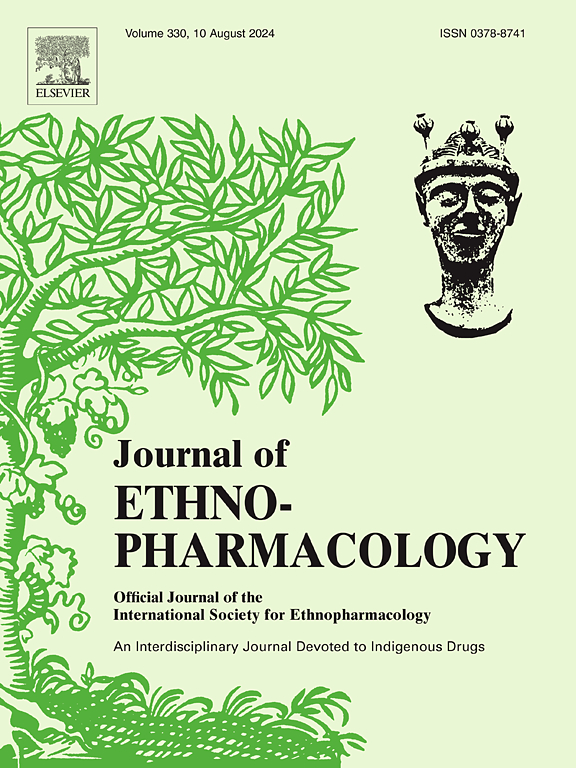Study on the embryotoxic effects and potential mechanisms of Aconitum diterpenoid alkaloids in rat whole embryo culture through morphological and transcriptomic analysis
IF 5.4
2区 医学
Q1 CHEMISTRY, MEDICINAL
引用次数: 0
Abstract
Ethnopharmacological relevance
The lateral root of Aconitum carmichaelii Debeaux, or Fuzi, is recognized in Asia for its anti-inflammatory, analgesic, and cardiotonic effects. Its main active compounds are diester diterpenoid alkaloids (DDAs) such as aconitine (AC), mesoacitine (MA), and hypoaconitine (HA), which are also toxic and have a narrow therapeutic window, limiting their clinical use. Although Aconitum DDAs are known for cardiotoxic and neurotoxic effects, their impact on embryonic development remains unclear.
Aim of the study
The embryotoxicity of three representative Aconitum DDAs (AC, MA, and HA) and their metabolites were systematically assessed, and the mechanisms underlying AC-induced embryotoxicity was explored.
Materials and methods
The embryotoxicity of these DDAs was assessed by indicators such as morphological scores in a whole embryo culture (WEC) system. Immunofluorescence analysis was conducted to detect DNA damage and apoptosis in embryos, and transcriptomic analysis and western blotting were performed to explore the underlying mechanisms.
Results
DDAs, particularly AC, induced dose-dependent developmental retardation and malformation in rat embryos. Notably, the embryotoxicity of AC metabolites such as benzoyltrypine (BAC) and aconine, was significantly reduced. AC treatment caused substantial DNA damage and apoptosis in embryos. Transcriptomic analysis indicate that AC treatment may impair DNA replication and histone synthesis by activating the p53/p21/CDK2/NPAT pathway, ultimately affecting embryonic development.
Conclusion
Among these Aconitum DDAs, AC exhibited the strongest embryotoxicity, mainly through DNA damage and regulation of histone genes via the p53/p21/CDK2/NPAT pathway.

通过形态学和转录组学分析研究乌头二萜生物碱对大鼠全胚的胚胎毒性作用及其可能机制。
民族药理学相关性:乌头(Aconitum carmichaelii Debeaux)或附子的侧根在亚洲因其抗炎、镇痛和强心作用而被认可。其主要活性成分为乌头碱(AC)、中亚乌头碱(MA)、次乌头碱(HA)等二酯二萜类生物碱(dda),同样具有毒性,治疗窗口较窄,限制了其临床应用。虽然已知乌头dda具有心脏毒性和神经毒性作用,但它们对胚胎发育的影响尚不清楚。研究目的:系统评价乌头3种典型DDAs (AC、MA和HA)及其代谢物的胚胎毒性,探讨AC诱导的胚胎毒性机制。材料与方法:采用全胚培养(WEC)系统中形态学评分等指标评价DDAs的胚胎毒性。免疫荧光检测胚胎DNA损伤和凋亡,转录组学分析和western blotting分析其机制。结果:DDAs,尤其是AC,会引起大鼠胚胎的剂量依赖性发育迟缓和畸形。值得注意的是,AC代谢物如苯甲酰胰碱(BAC)和乌头碱的胚胎毒性显著降低。AC处理导致胚胎DNA损伤和细胞凋亡。转录组学分析表明,AC处理可能通过激活p53/p21/CDK2/NPAT通路损害DNA复制和组蛋白合成,最终影响胚胎发育。结论:在这些乌头DDAs中,AC主要通过p53/p21/CDK2/NPAT通路对组蛋白基因的损伤和调控表现出最强的胚胎毒性。
本文章由计算机程序翻译,如有差异,请以英文原文为准。
求助全文
约1分钟内获得全文
求助全文
来源期刊

Journal of ethnopharmacology
医学-全科医学与补充医学
CiteScore
10.30
自引率
5.60%
发文量
967
审稿时长
77 days
期刊介绍:
The Journal of Ethnopharmacology is dedicated to the exchange of information and understandings about people''s use of plants, fungi, animals, microorganisms and minerals and their biological and pharmacological effects based on the principles established through international conventions. Early people confronted with illness and disease, discovered a wealth of useful therapeutic agents in the plant and animal kingdoms. The empirical knowledge of these medicinal substances and their toxic potential was passed on by oral tradition and sometimes recorded in herbals and other texts on materia medica. Many valuable drugs of today (e.g., atropine, ephedrine, tubocurarine, digoxin, reserpine) came into use through the study of indigenous remedies. Chemists continue to use plant-derived drugs (e.g., morphine, taxol, physostigmine, quinidine, emetine) as prototypes in their attempts to develop more effective and less toxic medicinals.
 求助内容:
求助内容: 应助结果提醒方式:
应助结果提醒方式:


